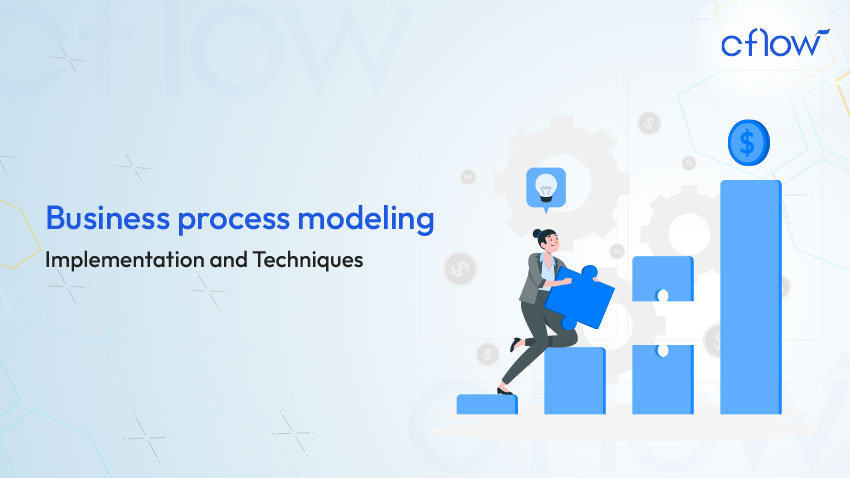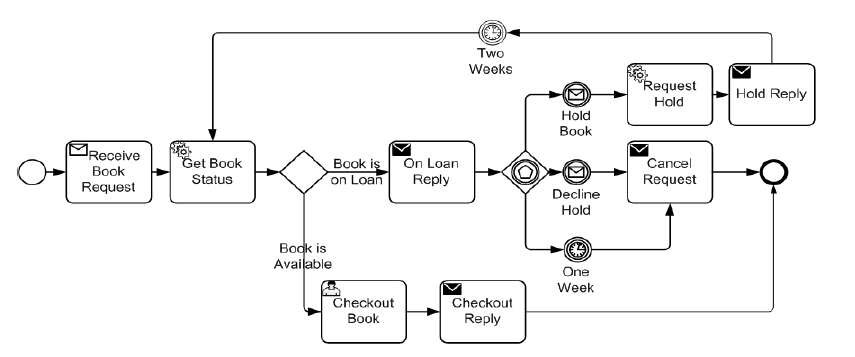What is Business Process Modeling and How to Implement it?

Key Takeaways
Business Process Modelling offers a visual blueprint of workflows across departments like sales, HR, and support, helping businesses identify inefficiencies and streamline operations.
Techniques like BPMN, UML Diagrams, Flowcharts, Gantt Charts, and PERT Diagrams each serve unique purposes—from simple task flow representation to complex time-bound project mapping.
BPM is especially useful when launching new processes, spotting bottlenecks, evaluating resources, and identifying areas fit for automation or cost reduction.
Visualising processes with BPM helps businesses make better decisions, standardise operations, and create more efficient, scalable workflows for long-term growth.
Using tools like Cflow, businesses can skip complex BPMN notations and instead model and automate processes easily with drag-and-drop builders and pre-built workflow templates.
Cflow’s intuitive modelling engine enables SMBs and large organisations to visualise, automate, and manage workflows with built-in features like cloud file access, reminders, and system integrations.
Every business has to perform to its full potential throughout the year, and the performance is tested multiple times during the year. Continuous business growth can be achieved only by a full understanding of how the business works. A picture is worth a thousand words, and a pictorial representation of all facets of the business, including sales, marketing, engineering, and support, is essential for a business to be successful.
Definition of Business Process Modelling
The term Business Process Modelling refers to creating a graphical representation of the different workflows in an organisation that captures the processes and the interactions between various departments. A clear picture of the current processes helps in identifying the backlogs and bottlenecks so that a better and more efficient process can be derived.
There are different tools to create a graphical view of your workflows. An organisation may not need to use multiple tools, but can find the most appropriate one that brings the most effective change to the processes.
What are the Different Business Process Modelling Techniques?
At a glance, a business may seem like a bunch of simple tasks combined to achieve a primary goal, such as procuring more customers or selling more goods, based on the type of business you run.
However, when you take a closer look, you will understand that there are a number of small yet important processes involving multiple stakeholders that need to work in unison toward a common goal.
A better understanding of workflows can be achieved through Business Process Modellin,g and here are the most widely accepted BPM techniques.
1. Business Process Modelling Notation (BPMN)
The pictorial representation using the BPMN (Business Process Modelling Notation) method, comprising standardised symbols to represent different activities and interactions, is popular among large enterprises around the world.

Source: https://methodandstyle.com/
The BPMN method is being mentioned in the first place because it is primarily designed for process modelling, unlike all other methods, whose original intent was different from process modelling.
Business analysts, financial experts, and process consultants choose BPMN to design processes as it is the standardised and widely acclaimed method for process definitions.
Here are the types of symbols and signs used in BPMN-
- Flow Objects – Circles are used to represent events in the Flow objects category, while rectangles with rounded corners represent activities, and diamond shapes showcase decision points.
- Connecting Objects – A dash, combined with the long line, is used to represent a task that has been transferred from one point to another, while dashed lines signify a message in between two processes.
- Swim Lanes – When two or more people have to coordinate and share work to complete it, swim lanes are used to represent them. Pool signifies the task, while lanes denote people or teams.
- Artifacts – These are used to fill in the missing information. Dotted lines show how additional information is added, squares outlined with dots and dashes help group elements, and a square bracket is used in annotating text.
2. UML Diagrams
UML Diagrams are one of the popular techniques of Business Process Modelling. UML stands for Unified Modelling Language, which was initially developed for software development.
UML is an object-oriented representation chart that depicts the relationship between the “actors” and “systems” and has different types, such as Use case diagrams, Sequence diagrams, Communication diagrams, and so on.
3. Flowcharts
Flowcharts are probably the only type of modelling in this list that needs no introduction, and people are instantly familiar with the concept.
Creating a flowchart is simple, and most business users will feel right at home. The only drawback is that flowcharts are useful for simple representations but lack the ability to model complex interactions in a single diagram. Flowcharts can showcase multiple workflows separately and need to be consolidated to truly represent the entire business process.
4. Gantt Charts
Gantt Charts are used by business experts as they help break down a complex task into multiple sub-tasks clearly linked by their dependencies. Each one of these subtasks has a specific time frame within which the task needs to be completed.
Gantt Charts are best for representing tasks that are driven by tight deadlines, as each task should be completed within a specific timeframe to achieve the desired results. It is also easy to edit and see the effect on timelines and dependencies. Companies that work on strict deadlines can easily keep track of workflows to make sure there is no delay.
5. PERT Diagrams
PERT Diagrams are widely accepted in the business community right after BPMN. They are abbreviated as the Program Evaluation and Review Technique, PERT.
A major advantage of using this technique is that, instead of creating theoretical solutions, it is used to represent a realistic timeline for a process to be completed. Here, users can create workflows using multiple methods and sources to identify the method that will help them complete the tasks in the least time.
End-to-end workflow automation
Build fully-customizable, no code process workflows in a jiffy.
What are the Advantages of Using Business Process Modeling?
Here are some scenarios where you might want to try one of the methods used for Business Process Modelling.
- Implementing a completely new process or project
- Identifying bottlenecks in current processes and getting rid of them
- Check the cycle times and resources used for further optimisation
- Identify redundant processes and consider automation solutions
- Find where investments and expenses are high in order to reduce them wherever possible
- Improve overall product and service quality by improving process efficiency
Advantages
- Get a clear picture of the entire organisational process
- Identify the interactions in processes and bring about improved workflows using a graphical representation
- Make important business decisions after a thorough review of current processes
- Understand the need for automation and stop redundant tasks from eating into your workforce’s precious time
- Create a better workflow process for the business to perform better and pave the way for future improvements and expansion
Cflow – An Automated, Easy-to-Implement Business Process Modelling Software
Cflow is primarily a workflow management software that also comes with a Business Process Modelling tool that is easy to use and ideal for business users. Cflow provides a proprietary and intuitive visual workflow builder for designing workflows instead of Business Process Modelling Notation. Cflow is fast and effective in automating business processes for SMBs as well as large organisations. The workflow templates are readily available, and you can automate most of your daily tasks in a matter of minutes.
Cflow has the power to quickly bring your workforce under its magical charm of automation. With automatic email reminders, cloud-based file access, and integrations with external systems, the business process modelling software has the power to help you get things done more efficiently than ever before. You can make use of the modelling tool to visualise and automate complex processes much faster.
Frequently Asked Questions (FAQs)
1. What exactly is Business Process Modelling, and why should I care?
Business Process Modelling (BPM) is a way to visually map out how your business works—from sales and marketing to HR and operations. Think of it like drawing a detailed blueprint of your workflows so you can see what’s working, what’s slowing you down, and where you can improve. It’s incredibly helpful when you’re trying to grow, scale, or fix inefficiencies.
2. How do I know which process modelling technique is right for my business?
It depends on your goals. If you want a detailed, standardised method used by enterprises, go with BPMN. If you’re into timelines and dependencies, Gantt charts are ideal. Flowcharts are great for beginners, while UML and PERT diagrams work well for more technical or time-sensitive workflows. Choose what makes the most sense for your team’s needs.
3. I’m not technical—can I still model and improve my business processes?
Absolutely. Tools like Cflow are built for non-technical users. You don’t need to learn BPMN or write code. Cflow uses a simple drag-and-drop visual builder, so anyone can create, edit, and automate workflows without help from IT.
4. When should I use business process modelling in my company?
Use it when you’re launching a new project, struggling with bottlenecks, trying to cut costs, or preparing for automation. It’s also great if you want to improve team collaboration or just get a clearer picture of how things are actually getting done.
5. Can business process modelling really help me save time and money?
Yes, and fast. By mapping out processes, you spot redundancies, delays, and manual tasks that could easily be automated. That means fewer errors, faster turnaround times, and more time for your team to focus on what really matters—growing the business.
Related Articles:
- Top 15 Business Process Management Software to Consider for 2025
- A Complete Guide to Business Process Automation
- BPM Tools to Manage Your Business Online
- Business Process Management Software – Explore the Top 10 BPM Software for 2025
- Business Process Management in Banking and Financial Industry
- Best BPM Companies to Consider in 2025
What should you do next?
Thanks for reading till the end. Here are 3 ways we can help you automate your business:

Do better workflow automation with Cflow
Create workflows with multiple steps, parallel reviewals. auto approvals, public forms, etc. to save time and cost.

Talk to a workflow expert
Get a 30-min. free consultation with our Workflow expert to optimize your daily tasks.

Get smarter with our workflow resources
Explore our workflow automation blogs, ebooks, and other resources to master workflow automation.

